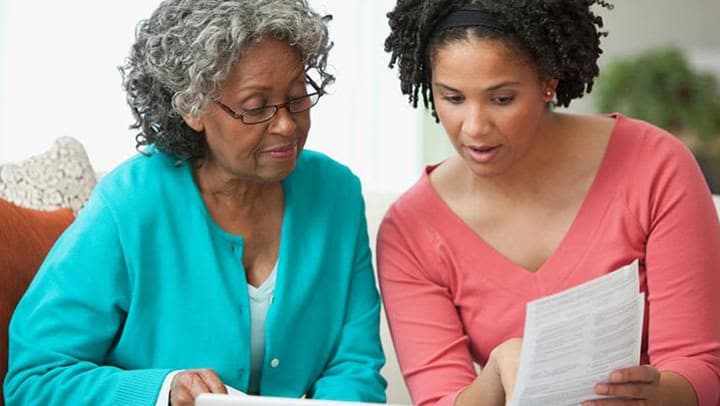Top 3 Steps in Disaster Preparedness for Seniors
Emergencies, such as snow and ice storms, can strike quickly, many times providing us with little warning, causing individuals to have to make difficult decisions on the fly: do I have proper supplies if I’m housebound? If we have a power outage, what will I do? How can I let my family know that I’m OK? Protecting yourself is your responsibility, and we’re here to help. If you’re an older adult living outside of a protected senior living community, the following are steps we’ve compiled to help you prepare if an emergency situation were to occur again.
1. Have a Support Network. For an aging adult, the most important resource in an emergency is a network of loving and efficient friends and family who can provide immediate assistance. Make a list of trusted individuals who you can rely on, contact them in advance, and relay important in-case-of-emergency information to them. This information includes items such as:
a. Exchanging home keys.
b. Showing them where emergency supplies and important documents are kept.
c. Reviewing communication methods if telephones aren’t working.
d. Sharing an escape destination with them so that they understand where to go.
2. Build a Home Kit. In the home kit, you should assemble supplies that will last for at least three to five days in the event of a home lockdown. A full list of basic supplies can be found on this American Red Cross’ disaster relief document. In addition to building this kit, you should also create labels with your name, address, and phone number for items such as walkers, wheelchairs, and even your emergency kit. If electrical power is lost, follow these guidelines:
a. Avoid using candles. Instead, opt for flashlights and battery-operated lanterns.
b. Unplug all major appliances that could be damaged by an electrical surge when the power is restored.
c. Invest into a portable generator. Use it cautiously, making sure it’s operated outdoors in a well-ventilated area. Refuel a generator only after it’s cooled and do not connect it to your home’s electrical system except through an approved transfer switch installed in compliance with the local electrical code.
3. Make a Family Communication Plan. Meet with loved ones every six months to review your disaster plan, how they will help you, and what everyone’s role will be in the event of an emergency. Keep all family members’ contact information handy in your wallet in a waterproof seal. Technology cannot always be depended upon so it’s a good idea to have a printed or written physical copy of their respective phone numbers and addresses.
In an increasingly digital world, a mobile device is usually our most relied upon resource during a disaster. Facebook has even developed a “Safety Check” crisis response, where users in threatened areas can mark themselves as “safe” so that family and friends know they’re okay.
However, when there’s a power outage, technology can become ineffective. Here are ways to ensure your phone doesn’t become a useless brick or, if it does, other communication options to choose from.
a. Backup Charger – A battery charger, or “juice pack,” for your phone or tablet will run you about $100 and can help your phone stay alive for longer. Some newer chargers can even use solar power, so if you have a dry spot outside to allow it to soak up the sun, Mother Nature can help you out. Utilizing a fully charged laptop can serve as a backup charger as well.
b. Charge Up in the Car – Keep a power inverter in the car and charge your phone through the car’s cigarette lighter outlet. The car is an under-appreciated piece of survival gear and can serve as a generator that charges many of your gadgets.
c. Walkie Talkies – If your cell phone goes, having a set of short-range communication devices can be lifesavers. A good option is the Motorola Talkabout T480 which have a range of up to 35 miles, hold a long battery life, and come in a pack of three.
Wind-Up, battery-powered radios may seem like a primitive technology in the digital age, but research suggests that our dependence on our phones could pose as a detriment in the event of a power outage. It’s important to have a backup device such as a radio that will relay updates about the weather conditions. Many use solar power, feature hand-cranks for back-up power, and even include flashlights.
In your family communication plan, discuss hypothetical scenarios of what should happen when. The most important part of this plan should include how you will communicate with your loved ones. For more information, check out FEMA’s Family Emergency Communication Plan document here.
While living independently offers its benefits to aging adults, senior living communities offer many benefits as well – particularly in the event of natural disasters. It’s mandatory for communities to have emergency protection plans in place that provide residents with immediate and efficient care because studies have proven that proper preparation saves lives.
If you’re an older adult and any part of this article felt daunting or made you question your own ability to stay safe and operate efficiently in the event of an emergency, then it may be a good time to explore the topic of senior living communities with your loved ones. Independent and assisted living communities provide a great protective option that will grant everyone involved peace of mind.
For more information about disaster preparedness for seniors, visit American Red Cross.


